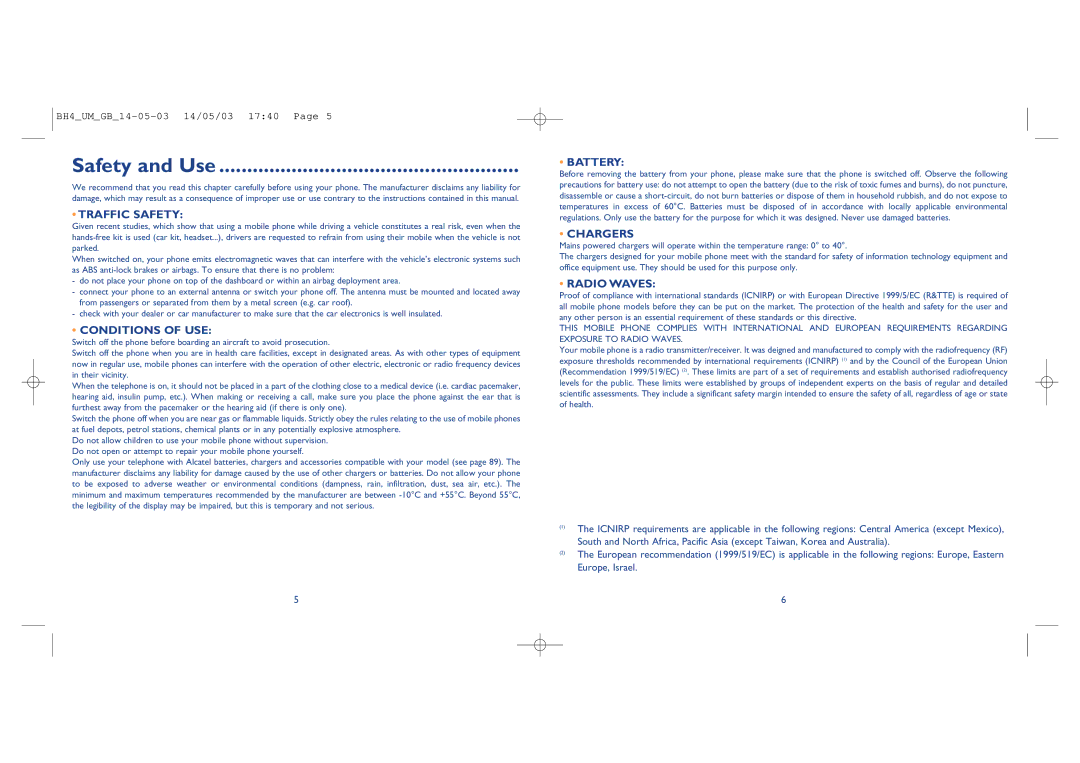
BH4_UM_GB_14-05-03 14/05/03 17:40 Page 5
Safety and Use ......................................................
We recommend that you read this chapter carefully before using your phone. The manufacturer disclaims any liability for damage, which may result as a consequence of improper use or use contrary to the instructions contained in this manual.
•TRAFFIC SAFETY:
Given recent studies, which show that using a mobile phone while driving a vehicle constitutes a real risk, even when the
When switched on, your phone emits electromagnetic waves that can interfere with the vehicle’s electronic systems such as ABS
-do not place your phone on top of the dashboard or within an airbag deployment area.
-connect your phone to an external antenna or switch your phone off. The antenna must be mounted and located away from passengers or separated from them by a metal screen (e.g. car roof).
-check with your dealer or car manufacturer to make sure that the car electronics is well insulated.
•CONDITIONS OF USE:
Switch off the phone before boarding an aircraft to avoid prosecution.
Switch off the phone when you are in health care facilities, except in designated areas. As with other types of equipment now in regular use, mobile phones can interfere with the operation of other electric, electronic or radio frequency devices in their vicinity.
When the telephone is on, it should not be placed in a part of the clothing close to a medical device (i.e. cardiac pacemaker, hearing aid, insulin pump, etc.). When making or receiving a call, make sure you place the phone against the ear that is furthest away from the pacemaker or the hearing aid (if there is only one).
Switch the phone off when you are near gas or flammable liquids. Strictly obey the rules relating to the use of mobile phones at fuel depots, petrol stations, chemical plants or in any potentially explosive atmosphere.
Do not allow children to use your mobile phone without supervision. Do not open or attempt to repair your mobile phone yourself.
Only use your telephone with Alcatel batteries, chargers and accessories compatible with your model (see page 89). The manufacturer disclaims any liability for damage caused by the use of other chargers or batteries. Do not allow your phone to be exposed to adverse weather or environmental conditions (dampness, rain, infiltration, dust, sea air, etc.). The minimum and maximum temperatures recommended by the manufacturer are between
5
•BATTERY:
Before removing the battery from your phone, please make sure that the phone is switched off. Observe the following precautions for battery use: do not attempt to open the battery (due to the risk of toxic fumes and burns), do not puncture, disassemble or cause a
•CHARGERS
Mains powered chargers will operate within the temperature range: 0° to 40°.
The chargers designed for your mobile phone meet with the standard for safety of information technology equipment and office equipment use. They should be used for this purpose only.
•RADIO WAVES:
Proof of compliance with international standards (ICNIRP) or with European Directive 1999/5/EC (R&TTE) is required of all mobile phone models before they can be put on the market. The protection of the health and safety for the user and any other person is an essential requirement of these standards or this directive.
THIS MOBILE PHONE COMPLIES WITH INTERNATIONAL AND EUROPEAN REQUIREMENTS REGARDING EXPOSURE TO RADIO WAVES.
Your mobile phone is a radio transmitter/receiver. It was deigned and manufactured to comply with the radiofrequency (RF) exposure thresholds recommended by international requirements (ICNIRP) (1) and by the Council of the European Union (Recommendation 1999/519/EC) (2). These limits are part of a set of requirements and establish authorised radiofrequency levels for the public. These limits were established by groups of independent experts on the basis of regular and detailed scientific assessments. They include a significant safety margin intended to ensure the safety of all, regardless of age or state of health.
(1)The ICNIRP requirements are applicable in the following regions: Central America (except Mexico), South and North Africa, Pacific Asia (except Taiwan, Korea and Australia).
(2)The European recommendation (1999/519/EC) is applicable in the following regions: Europe, Eastern Europe, Israel.
6
